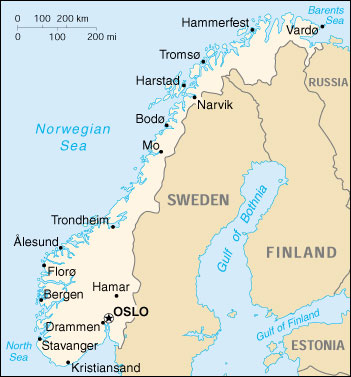| Motorhome rental, RV rent and Campervan hire in Norway - Utleier Bobiler i Norge |

Where to go in NorwayNorway is a ruggedly beautiful country of mountains, fjords and glaciers. It is famous for its fjord-indented coastline and its mountains, ski resorts, lakes and woods. Famous cities in Norway include the capital Oslo with its castle, its cathedral, its picturesque landscape and interesting architecture. On the west coast there are the cities of Bergen and Stavanger, each of them set alongside a fjord. Preikestolen is located in Lysefjorden right outside Stavanger. It is a cliff hanging 604 metres directly above the water. In the south you find the city of Kristiansand which is the fifth largest in Norway, and to many it is a favourite holiday city. Trondheim, Norway's first capital, is home to the largest medieval cathedral in Scandinavia, Nidaros Cathedral. Tromsø, gateway to the arctic, is situated 400 km north of the arctic circle in the midst of a stunning landscape of mountains and fjords.Road conditions / restrictionsPublic transportation in Norway is generally safe and the maintenance and condition of urban roads are generally good. Rural road conditions are fair, and the availability of roadside assistance is limited.- The roadway system beyond Oslo's limits and other major cities tends to be simple two-lane roads. Where to campCamping/campsites Type of motorhome(s)Hightop or campervan Driving licenseIf you are a resident of a Nordic country or the European Economic Area (EEA) you need only a valid driver's license from your home country. else you need an International Driving Permit in addition to your driver's license from your home country, VisaGeneral European Visa rules apply.HealthNorway has reciprocal agreements with Austria, Belgium, Cyprus, the Czech Republic, Denmark, Estonia, Finland, France, Germany, Greece, Hungary, Iceland, Ireland, Italy, Latvia, Liechtenstein, Lithuania, Luxembourg, Malta, Netherlands, Poland, Portugal, Slovakia, Slovenia, Spain, the United Kingdom, Sweden and Switzerland. A European Health Insurance Card (EHIC) is necessary for this purpose.Emergency telephone numbers110 - Fire112 - Police 113 - Ambulance Best time to visitIn the summer the average temperature in Norway ranges from 57°F to 65°F (13°C-18°C). In January it hovers around 27°F (2°C), ideal weather for winter sports. The Gulf Stream warms the west coast, where winters tend to be temperate. Rainfall, however, is often heavy here. Above the Arctic Circle the sun shines night and day from mid-May until late July. For about 2 months every winter, the North Cape is plunged into darkness.Late June to early August is the high season in Norway, when the weather is warmest and the schools are on holiday. The most popular tourist places can be busy, but finding peace and quiet, if you wish, is easy. All the man-made tourist attractions are open, and public transport services are more frequent. CurrencyThe Norwegian currency consists of "kroner" (NOK) and "øre". 100 øre make up 1 krone. LanguageNorwegian (Bokmål and Nynorsk). In some districts, Sámi is also an official language. Electricity220 volts AC (50 Hz) is the Norwegian standard. If you are traveling with electrical or electronic devices be sure to bring a two-pin continental adapter with you. |
||||||
 Norway
Norway 
